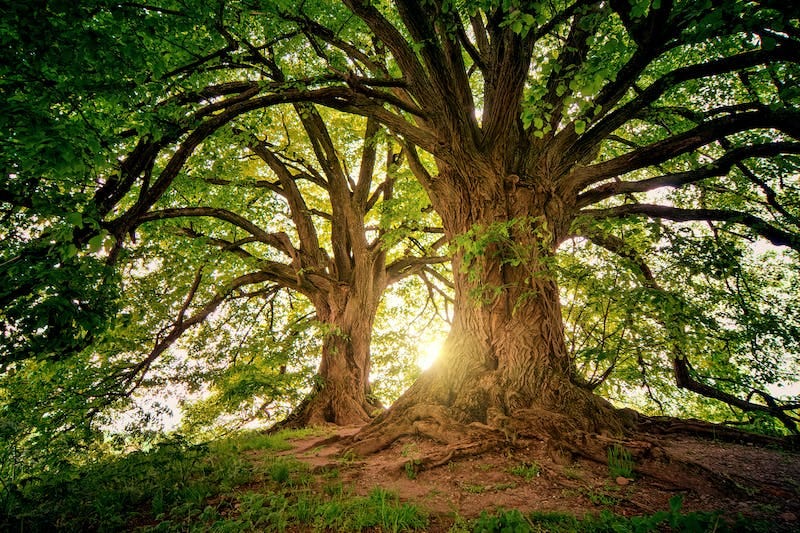🍄 Trees Talking
Globally, there are estimated 3.04 trillion trees—roughly 422 trees for every person on earth. Trees talk, signal and sense. Can we listen?
From the minds of Sputnik Futures. Exploring every rabbit hole there is. For more wanderings, become an Alice in Futureland subscriber—it's free.
🍄 AudioDose: this is Alice on Sonic Mushrooms. Earth sonics here.
🎧 Alice in Futureland Podcasts
📘 ALICE book Tuning into Frequency: The invisible force that heals us and the planet.
Hello, we’re Alice, and we are always in a state of wander. Have you heard trees talk to one another? Trees communicate and cooperate in ways we’re just starting to uncover. Beneath the canopies, they form alliances with each other and fungi friends. Now, humans seek to plug into this underground system and get to the root of its sharing and caring social network.
‘The people [aborigines] themselves say, “Don’t you know anything? The plants talk to us.” And you begin to think, Well, maybe it’s true.’ —Wade Davis, explorer in residence, National Geographic, ALICE interview.
Between The Pines
Maybe it’s not a fairytale and the forest really is enchanted. Studies show that trees thrive with community spirit and constant conversation that humans can’t hear. Branches bristle with invisible information, roots hide messages and missives are sent through scent. That compelling fragrance of a conifer forest? It’s actually a sign of stress signaling between trees, warning of dry weather and insect attacks. The good news is that by communicating in this way with each other - and their offspring - the little ones learn to deal with climate change. So the next generation will be more resilient. “Old trees are like libraries and they’re able to pass down their knowledge to seedlings,” says German forester Peter Wohlleben, author of The Power of Trees: How Ancient Forests Can Save Us If We Let Them (2023), and New York Times-bestseller The Hidden Life of Trees (2015). “We need to stop thinking of them as green stones, and start thinking of them as intelligent cooperative ecosystems.”
One Trunk or Two?
‘Mushrooms are the window through which I came to understand nature in a deeper way,’ writes food and nature writer and mycologist, Eugenia Bone, American author of ‘Mycophilia: Revelations From The Weird World of Mushrooms.’ ‘It was the story of mushrooms, of fungi, that introduced me to the glorious symbiosis, the interdependence, of all organisms, both seen and unseen.’
The mushroom family also breaks bread. In a vital role, fungi networks have been found to feed each other nutrients through a subterranean maze, dubbed the ‘Wood Wide Web.’ And there’s plenty enough for everyone. ‘Mycorrhiza’ are fungi that grow entwined with tree and plant roots, and they’re basically best friends. Operating something of a swap shop, mycorrhiza exist by taking sugars from plants in ‘exchange’ for moisture and nutrients collected from the soil by the fungal strands. It’s the ‘Earth’s natural internet,’ according to mycologist expert Paul Stamets, whom ALICE interviewed in 2002. Or, “an information superhighway,” as science writer and mycologist Nic Fleming says. In the film, Avatar [2009], the character Dr. Grace Augustine sees the symbiotic relationship in the Pandora forest and calls it “some kind of electrochemical communication between the roots and the trees.”
Stamets told ALICE that there can be up to two to three hundred species of fungi under one Douglas fir tree. “The host defense of the planet is dependent upon these fungal organisms, these giant neurological landscapes, because they’re sentient, they’re intelligent,” he said. “When a tree falls or a person chops wood, or even when you walk down a trail, you’re breaking sticks and you’re exposing this carbon source. And, because of the competition of nature, these fungi leap out of the background, trying to recycle this. And so, because of the complexity of the fungal-biome, we have an ability to repair ecosystems.”
As to how it works exactly, scientists are still sort of stumped.
Going Underground
No one really knows what’s going on. Humans, who have existed for just 0.1% of the time that trees have (around 400 million years), have largely ignored their leafy neighbor’s great prowess. We’ve worked out what they can do for us, but not really what they’re doing for each other. Science has a lot to catch up, but the feelers are out. Probing into potential ‘heartbeats’ of trees, how root tips are the ‘brains’ of the tree and mysterious sleeping patterns. But the puzzle doesn’t stop there.
Turns out while we were sleeping, nature created Earth’s first electrical grid. In meadows, marshes, and river bottoms, electroactive bacteria are busy building an infrastructure to shuttle subtle frequencies to help control the chemistry of the Earth. Plants feel sound as well as hear it, and some of the most meaningful audio communication happens at frequencies that humans can't hear.
Communal Living
Humans haven’t always been on the outside looking in. Aboriginal cultures regarded trees as community members and there was a time when we all noticed and listened to nature, were more closely connected. In the book, Nature Speaks: Medieval Literature and Aristotelian Philosophy, author Kellie Robertson assesses what is gained and what is lost when nature's voice goes silent. She explores how philosophers and pre-modern writers used nature as a tool, asking; is human experience independent of the natural world in which it is forged?
That influence clearly waned, we dropped out of the conversation but still remember to water the plants. Today, we rarely notice trees—a phenomenon that scientists have described as ‘plant blindness.’ It’s generally defined as our inability to see or notice plants in our environment and inability to recognize their importance in the biosphere.
Wood Wide Web
In his book, The Song of Trees, author George David Haskell says that understanding that nature is a network is the first step in hearing trees talk.
Deep in the Amazon rainforest in Ecuador, he explains, the Waorani people living there have embraced nature’s network into their everyday language. Objects are described not as alone, but as connected. There is no lone ‘ceibo tree.’ There is ‘the ivy-wrapped ceibo’, or ‘the mossy ceibo with black mushrooms.’ Haskell writes, “when pressed by interviewers, Waorani ‘could not bring themselves’ to give individual names for what Westerners call ‘tree species’ without describing ecological context such as composition of the surrounding vegetation.”
Because we know so little about the intricacies of Wood Wide Web, even the experts constantly chop and change their minds. Foresters traditionally placed higher value on younger trees, cutting down the elder trees and clearing away their knowledge. “Forest trees were often cut very young at 50 to 100 years—but we now know that one percent of the oldest trees contain fifty percent of the bio mass— that means they are the main carbon storers, and have the most knowledge,” Peter Wohlleben told ABC Radio National in May.
Here’s what we do know: Trees are our best climate-change allies. They absorb carbon dioxide (CO2), removing and storing the carbon while releasing the oxygen back into the air. In one year, an acre of mature trees absorbs the amount of CO2 produced by a car driven 26,000 miles.
Mother Knows Best
Just like us, trees learn the way of the world from their parents.
“We have learned that mother trees recognize and talk with their kin, shaping future generations. In addition, injured trees pass their legacies on to their neighbors, affecting gene regulation, defense chemistry, and resilience in the forest community.”
― Peter Wohlleben, The Hidden Life of Trees: What They Feel, How They Communicate—Discoveries from A Secret World
Experimenting in this area is forest ecologist, Suzanne Simard, a trailblazing researcher of Canadian trees for over thirty years. “When mother trees are injured or dying, they send messages of wisdom on to the next generation of seedlings,” she says. Simard specializes in the underground movement of trees, and their connection to the fungal network. “We used isotope tracing to trace carbon moving from an injured mother tree down her trunk into the mycorrhizal network and into her neighboring seedlings, not only carbon but also defense signals. And these two compounds have increased the resistance of those seedlings to future stresses. So trees talk."
Check out Simard’s 2016 TED Talk, “How trees talk to each other,” which has been viewed over five million times.
Nepo-Babies
Simard also discovered that trees recognize their own kin. “Now, we know we all favor our own children, and I wondered, could Douglas fir recognize its own kin, like mama grizzly and her cub?” Simard says. “So we set about an experiment, and we grew mother trees with kin and stranger's seedlings. And it turns out they do recognize their kin. Mother trees colonize their kin with bigger mycorrhizal networks. They send them more carbon below ground. They even reduce their own root competition to make elbowroom for their kids.”
Trees also practice helicopter-parenting—they create a canopy over the younger ones, allowing very little light to get through. Trees need light to grow, but studies show slow growth in the young helps them to live longer and stronger. By growing in this way, they remain resistant to storms and wind, and become tougher in the fight against damaging fungi. It was found that by the age of eighty, trees are entering adolescence stronger than ever.
Perhaps there’s something to slow growth that we humans should listen, and learn.
Leading Indicators
🧠 The Real Immortalists
The average life span of a tree is 300 - 400 years, and the oldest living tree is more than 5,000 years old. But scientists today theorize that trees could potentially live forever. If left to thrive, trees don’t really die of old age—rather they are killed by human or environmental damage. According to Franco Biondi, an ecoclimatologist and tree-ring scientist at the University of Nevada, Reno. “Trees can indeed live indefinitely, but this does not happen.”
🧠 Alarm Smells
Trees don’t say it, they spray it. Research from the German University of Leipzig, has shown that oak trees call birds for help. It’s the first time a chemical ‘cry for help’ from trees has been verified in a natural habitat. Recorded in the canopy of the Leipzig floodplain forest, trees emit scents when attacked by caterpillars and other herbivores. They use these to attract predatory insects and birds, who rid the place of pests.
🧠 Care Packages
Trees are dishing out a sort of communal stone soup. At the University of British Columbia, ecologist Suzanne Simard discovered that shaded fir trees receive carbon in the summer from sun-laden birch trees, while in the fall, firs reciprocate. The birch receives carbon from the fir tree. Simard found that the exchange takes place through the mycorrhizal network, yes, that famous fungus highway!
🧠 Sleeping Duty
Flowers close their petals at night, and it seems that trees could sleep too. Using laser scans, Dr. András Zlinszky, a remote sensing researcher currently at the Balaton Limnological Institute in Tihany, Hungary, found that birch trees hang their branches around 10 cm at night, and bring them back up with the sunrise. They then measured 22 more species of trees and saw that the branches changed positions not only morning and night, but also at the three-four hour intervals—lifting their branches up and down for the circulation of water and sugars.
🧠 Forest Bathing
Shinrin-yoku, the Japanese practice of forest bathing, has been the rage of late—and for good reason. Medical research concluded that forest bathing activities may significantly improve people’s physical and psychological health, remarkably improving cardiovascular function; immunity, inflammatory, antioxidant indexes; significantly enhancing people’s emotional state, attitude, and feelings towards things; physical and psychological recovery; adaptive behaviors; and notable alleviation of anxiety and depression. Perhaps the Brothers Grimm knew best 😊.
What Else We Are Wondering
🔍 Plant ESP
Back in the 1970s, Cleve Backster had a whim: Could plants sense danger? Working as an expert in lie detection with the CIA, he hooked up the machine’s galvanometer— the sensor that measures small electrical currents, or heart rate changes—to a leaf of a dracaena, a common house plant. Backster tested the plant by imagining the dracaena was being set on fire. When he did, the plant reacted with a surge of electrical activity that was registered on the polygraph machine. Backster didn’t stop there—he attempted to elicit fear by setting one of the plant’s leaves on fire, but before he could even light the match, the polygraph registered an intense reaction from the leaf. The plant seemingly felt that he was about to burn it. Backster found that the plant not only demonstrated fear but also could somehow read his mind or comprehend his intentions—that it could be conscious. This plant ESP phenomenon was named the “Backster Effect.” The recordings of his experiments can be found in his book Primary Perception: Biocommunication with Plants, Living Foods, and Human Cells. (Source: WorldCat.org)
🔍 Mud Vibes Only
Roots are a sensitive subject. Root tips are considered to be the ‘brain’ of the tree and can feel, taste and touch. They slip, slide, duck and dive (ok, likely at a very slow pace) through the earth and even decide to grow in the direction of water. If they feel stones they’ll reroute for a smoother ride.
You may already know from our ‘Call of the Wild’ newsletter that some animals communicate using vibrations far too high and low for the human ear to hear. Similarly, plants also use vibrations to sense potential invaders.
“Plants detect vibrations in a frequency-selective manner, using this “hearing” sense to find water by sending out acoustic emissions and to communicate threats,” writes Garth Paine, a Professor of Digital Sound and Interactive Media, Arizona State University and acoustic ecologist, in The Conversation. “We also know that clear verbal communication is critical, but is easily degraded by extraneous sounds, otherwise known as “noise.”
🔍 Music of the Plants
Plants are musical, and we can hear them play through biosonification devices. Music of the Plants is one device that deciphers and registers the impulses and interactions of plants through a device that uses a MIDI (musical instrument digital interface), which transforms the plant's inner movement from a leaf to the root system into music. PlantWave is another digital interface that turns a plant’s biorhythms into music. Developed by multimedia healing artists founders of Data Garden, PlantWave acts like an external drive that records the slight electrical variations in a plant via two electrodes placed on the leaves. These variations are translated into pitch messages that play musical instruments. With the PlantWave digital recorder and app, you can literally have a playlist of your home or garden plants music!
Craving more?
📘 Alice in Futureland books
🎧 Alice in Futureland podcasts
Thanks for tuning in.
For more wanderings, become an Alice in Futureland subscriber—it's free.
Invite your friends to this mad tea party and let's see how many things we can learn before breakfast.
©2023 Alice in Futureland








